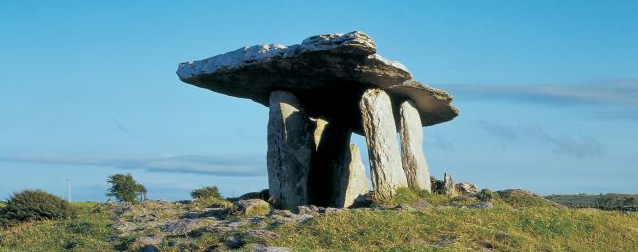Blog Categories
Blog CategoriesImpressions of Ireland - Dolmens
Dolmen – the word means stone table. One of the most astonishing sights in the physical landscape of Ireland is the sight of a dolmen.
Dating back to around 2,500 BC, these extraordinary prehistoric monuments have a large concentration in eastern areas of Ireland, particularly along the coast.
 |
| Poulnabrone, County Clare |
There are about 190 dolmens around Ireland and they are clearly recognizable. There are many different names for dolmens: Giants Graves, Cromleachs, Leabas, stone tables or the beds of Diarmuid and Grainne.
Dolmens were used to commemorate the dead and are also thought to have acted as centers for various ceremonies in the area. They are particularly interesting in that they represented the first real attempt by the settlers to organize and shape the landscape around them.
They generally have an entrance feature, which is a massive roof stone which usually weighs many tones and is inclined at an angle with the highest part over the entrance.
Many dolmens were covered with large mounds of stone but at many sites, little remains now of these cairns and what is left is just an indication of what was there originally.
Three interesting dolmens that are well worth a visit are in Dublin, Sligo and Clare:
Kilternan, County Dublin
One of the largest dolmens in Ireland is the dolmen or portal tomb located at Kilternan, dating from the Neolithic period or New Stone Age, from 4,000 BC - 2,500 BC. The granite covering stone of the dolmen measures approximately 7 meters x 5.18 meters x 1.83 meters. The rectangular chamber beneath measures 15 feet in length and 10 feet in breadth. It is astounding to historians that these early settlers managed to lift the huge capstone in to position as it is estimated to weigh over 25 tonnes.
Poulnabrone, County Clare
Poulnabrone portal dolmen in County Clare is perhaps the best known neolithic monument in the whole of Ireland. Poll na mBron in Irish means ‘hole of the quern stones’ and is located in a beautiful setting in the Burren in County Clare. Five miles south of Ballyvaughan it is thought to date from between 4200 BC and 2900 BC.
Cloghcor, County Sligo
Cloghcor in north Sligo is a massive dolmen found on the summit of a drumlin near the end of the Magherow peninsula. What is significant about this is that it is found in an open area as traditionally dolmens were found in sheltered locations, usually near water. There are magnificent views from this dolmen, which consists of two massive portal stones and each is over three meters high. In its heyday it would have been visible for many miles around.
Both visitors to Ireland and locals are drawn towards these magnificent prehistoric monuments and the amazing feats of strength and ingenuity needed to build them, plus their mystical background ensures that they remain as magical as ever.
